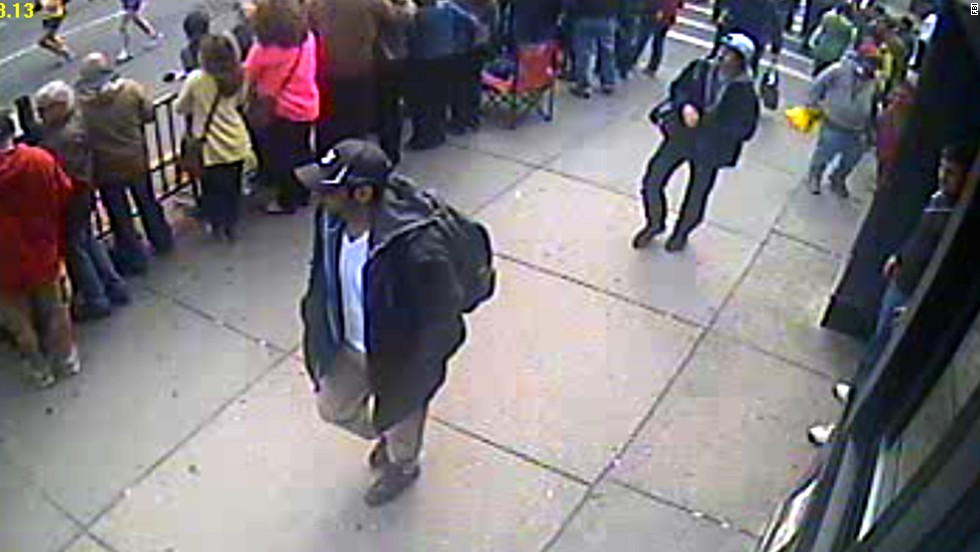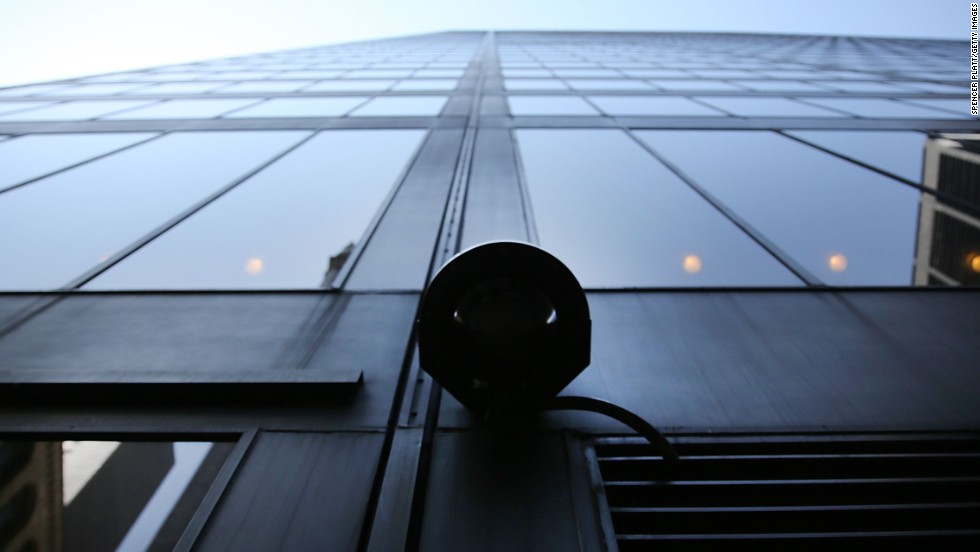After Boston: The pros and cons of surveillance cameras
Even after the identification of the
Boston bombing suspects through grainy security-camera images, officials
say that blanketing a city in surveillance cameras can create as many
problems as it solves.
A network of
cameras on city streets and other public spaces increases the chances of
capturing a criminal on video but can generate an overwhelming amount
of evidence to sift through. The cameras make some people feel more
secure, knowing that bad guys are being watched. But privacy advocates
and other citizens are uneasy with the idea that Big Brother is
monitoring their every public move.
Meanwhile,
facial-recognition software and other technologies are making
security-camera images more valuable to law enforcement. Now, software
can automatically mine surveillance footage for information, such as a
specific person's face, and create a giant searchable database.
After
last week's bombings at the Boston Marathon, authorities had to sift
through a mountain of footage from government surveillance cameras,
private security cameras and imagery shot by bystanders on smartphones.
It took the FBI only three days to release blurry shots of the two
suspects, taken by a department store's cameras.
Compare
their quick turnaround with the 2005 London bombings, when it took
thousands of investigators weeks to parse the city's CCTV
(closed-circuit television) footage after the attacks. The cameras,
software and algorithms have come a long way in eight years.

The FBI last week released security-camera images of suspects in the deadly Boston Marathon bombings.
Cities under surveillance
In major cities, in the age of terrorism, someone is almost always watching.
The
cameras used in London are part of the city's extensive and
sophisticated "Ring of Steel" surveillance system that combines nearly a
half million cameras, roadblocks and license plate readers to monitor
the heart of the city. Set up in 1998, the system is one of the most
advanced in the world and allows authorities to track anyone going into
or out of central London.
Many
residents question the effectiveness of London's system, however. In
2008, only one crime was solved for every 1,000 cameras, according to
the city's police. CCTV cameras across Britain also cost authorities
nearly $800 million over the past four years, according to civil
liberties group
Big Brother Watch.
Modeled after London's system, New York's
Lower Manhattan Security Initiative
monitors 4,000 security cameras and license plate readers south of
Canal Street. The project uses feeds from both private and public
security cameras, which are are all monitored 24 hours a day by the
NYPD.
Using face and object-detection
technology, the police can track cars and people moving through 1.7
square miles in lower Manhattan and even detect unattended packages. The
$150 million initiative also includes a number of radiation detectors
and automatic roadblocks that can can be used to stop traffic in an
emergency.
Boston's camera network is
smaller than those in London and New York, though that is likely to
change soon. In 2007, Boston law enforcement had an estimated 55 CCTV
cameras set up around the city. Since then, the city has expanded its
surveillance system, though authorities there are not commenting on the
exact scope of the current camera setup.
Boston's
example has shown the power of these systems to help solve crimes,
causing many to call for even more cameras. But it's still not clear
whether they are effective at preventing crimes. According to the
Surveillance Studies Centre at Queen's University in Ontario, urban surveillance systems have not been proven to have any effect on deterring criminals.
Facial recognition
As
the volume and quality of cameras and sensors are ramped up, cities are
turning to more advanced face- and object-recognition software to makes
sense of the data.

A surveillance camera attached to a building in the Financial District of New York City.
"We
describe what's in the video, and we store that in a database," said Al
Shipp, CEO of San Francisco-based 3VR, one of several companies that
makes this type of facial-recognition technology.
The
company's first investor was In-Q-Tel, the CIA's venture-capital arm,
which finds and funds promising security-related technology. Now, 3VR
works with federal and local law enforcement agencies, as well as
private companies and banks.
Its
software can identify objects by shape, size and color. It can read
license plates and recognize cars. When it comes to people, it can
detect their gender, approximate age, mood and other demographic
information. Using multiple cameras, it can track their patterns and
some behaviors. It automatically zooms in on any person's face and
identifies them based on things like the distance between their eyes or
the shape of their nose.
All that
information is stored in a database. Big clues that would take a
traditional investigator untold hours of watching video to uncover can
be found with a 15-second search query.
For
example, they could do a search for anyone who entered a 7-Eleven store
between 8 and 11 p.m. on a specific night, pull up the times that
certain cars have entered and left a parking lot, or ask for images of
every person who has entered a certain building over the past year.
"It
instantaneously gives you a picture of everybody who has walked in the
door in the past based on the geometries of their face," Shipp said.
Privacy concerns
Civil-liberties
activists are concerned about how this technology could be abused. With
cameras in far-flung cities all connecting to the same database, a
person's movements can be tracked across states or continents. For
example, it could be used to single out a person attending multiple
political protests.
"We like to think
we have some privacy in our lives, that we can go places that we don't
necessarily want the government to know about," said said Jennifer
Lynch, an attorney at the Electronic Frontier Foundation, an Internet
civil-liberties group. "What concerns me is if all of those cameras get
linked together at some point, and if we apply facial recognition on the
back end, we'll be able to track people wherever they go."
For
now, many of the biometrics databases in the United States are still
separated. Some are scattered across various federal and local
government agencies, and connecting them will take time and big budgets.
The FBI is in the process of building out its own facial-recognition
database and is working with state DMVs to access their photos.
It's
less likely the government will be able to tap into private databases
anytime soon, but it's still a cause for concern down the line, privacy
advocates say. Facebook has the largest facial-recognition database in
the world, a potentially rich vein of data for any government agency.
Another
worry is the misidentification of suspects. Shipp acknowledges that
these systems can make mistakes but says the computers aren't there to
take over for humans but to assist investigators by weeding out useless
information.
"The cameras themselves are not a panacea. They're not going to solve the problem. It's one of the steps," he said.
But at least one prominent tech blogger thinks the benefits of surveillance cameras outweigh our fears about privacy.
"The
idea of submitting to constant monitoring feels wrong, nearly
un-American, to most of us. Cameras in the sky are the ultimate
manifestation of Big Brother -- way for the government to watch you all
the time, everywhere," Farhad Manjoo wrote last week in Slate.
But Manjoo thinks we need to be thinking about ways to make cameras work for us, not reasons to abolish them.
"When
you weigh cameras against other security measures, they emerge as the
least costly and most effective choice. In the aftermath of 9/11, we've
turned most public spaces into fortresses -- now, it's impossible for
you to get into tall buildings, airports, many museums, concerts, and
even public celebrations without being subjected to pat-downs and metal
detectors. When combined with competent law enforcement, surveillance
cameras are more effective, less intrusive, less psychologically
draining, and much more pleasant than these alternatives."
If you or Someone you know is looking for high quality video surveillance or other security needs please visit out website at www.hdview360.com
source :http://www.cnn.com/2013/04/26/tech/innovation/security-cameras-boston-bombings/
 The National Security Agency (NSA) has set a date to purge phone records collected during its bulk surveillance program.
The National Security Agency (NSA) has set a date to purge phone records collected during its bulk surveillance program.




